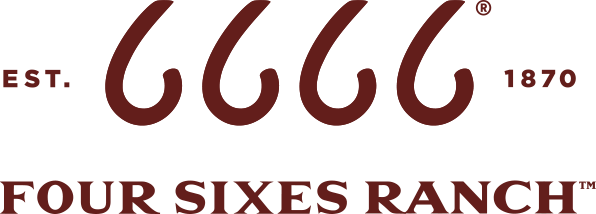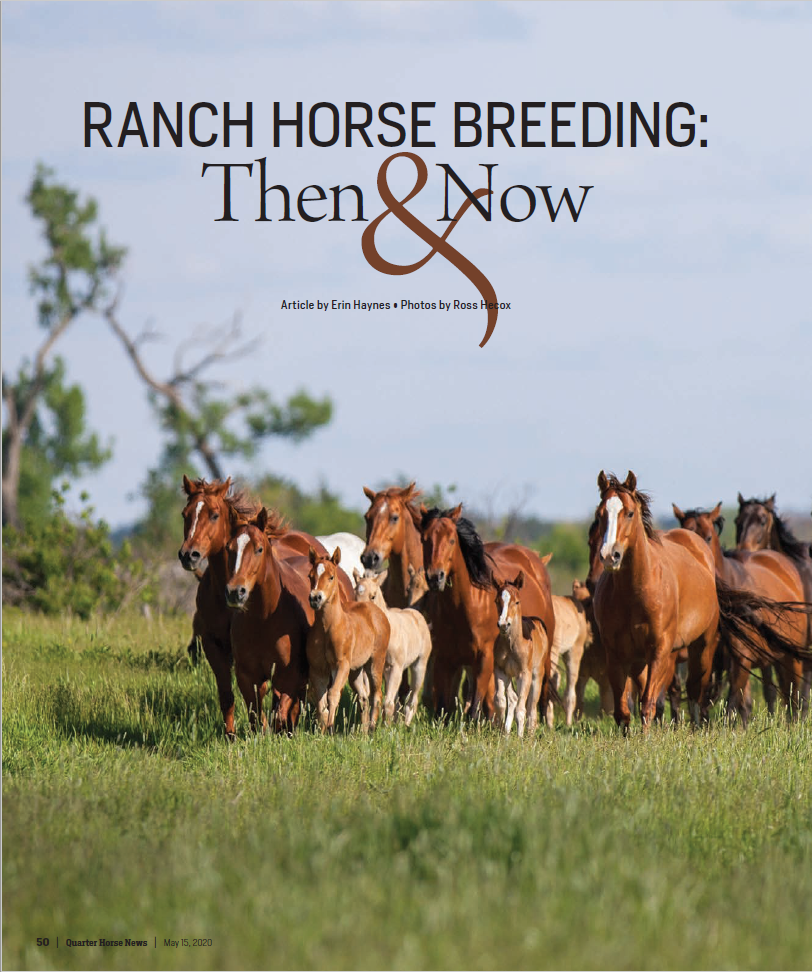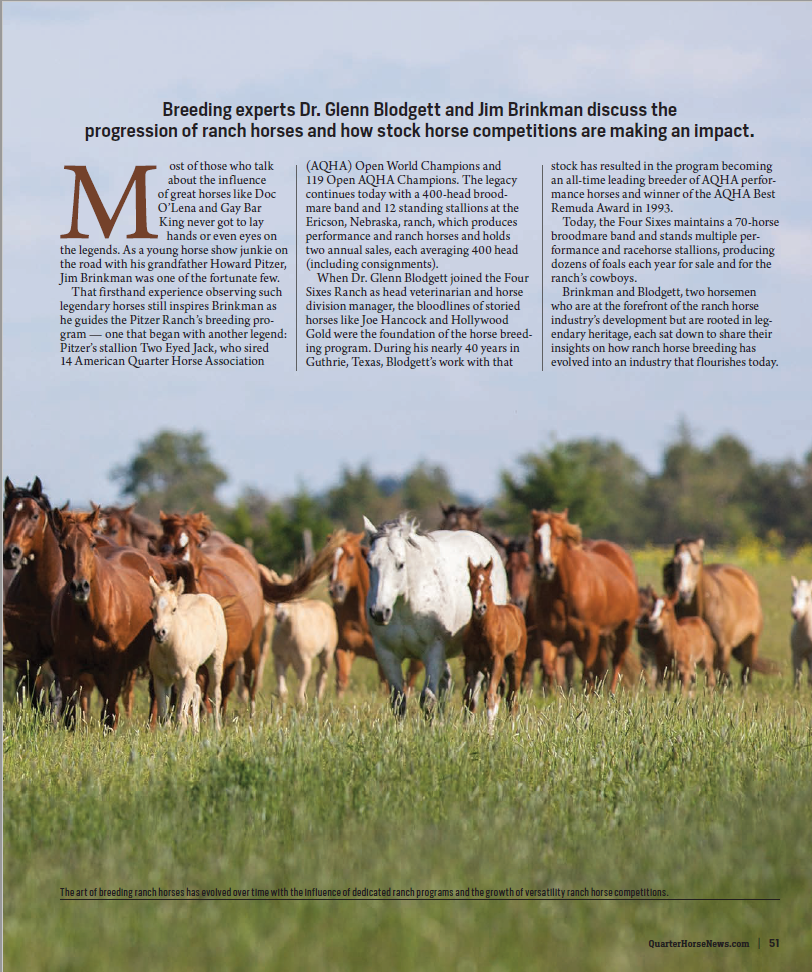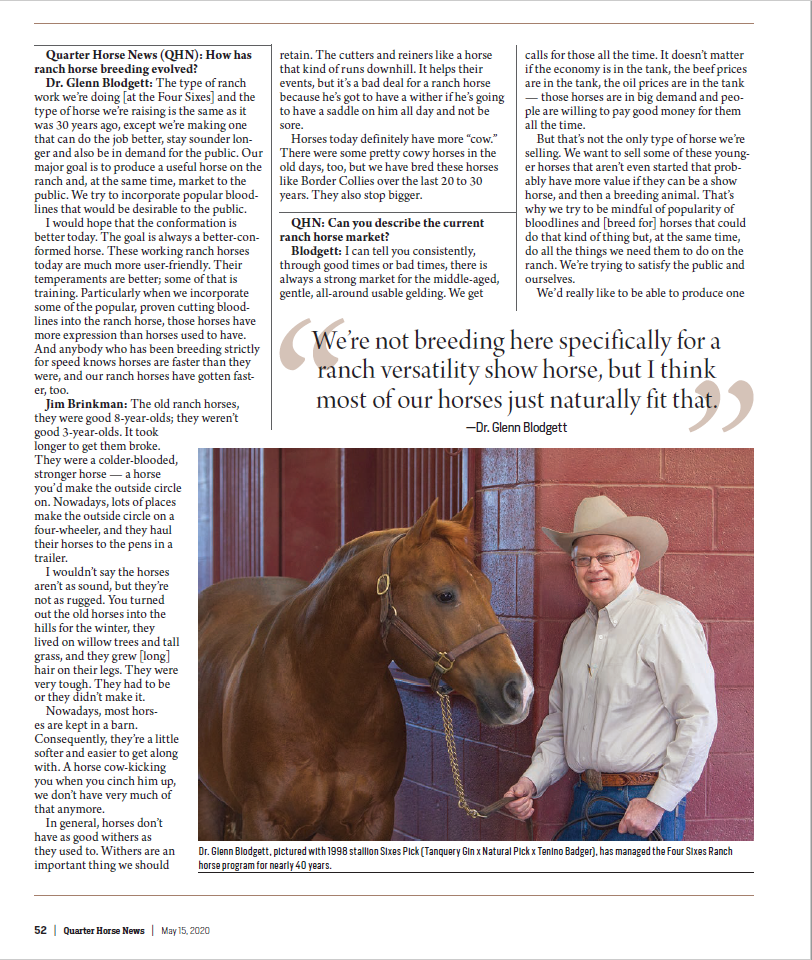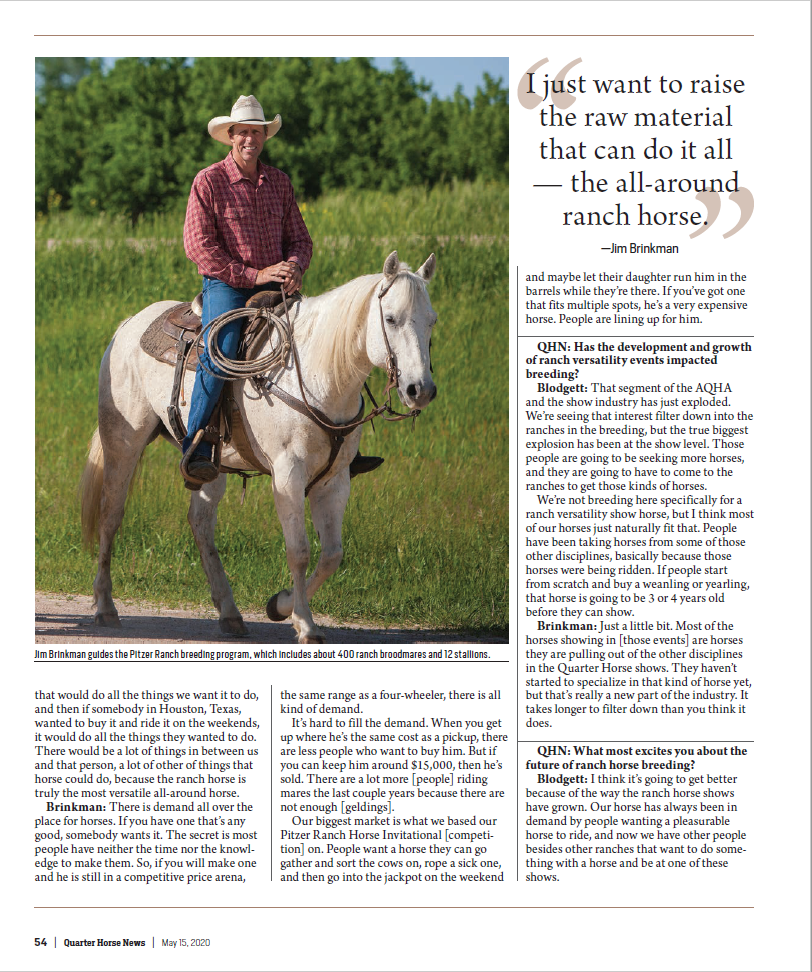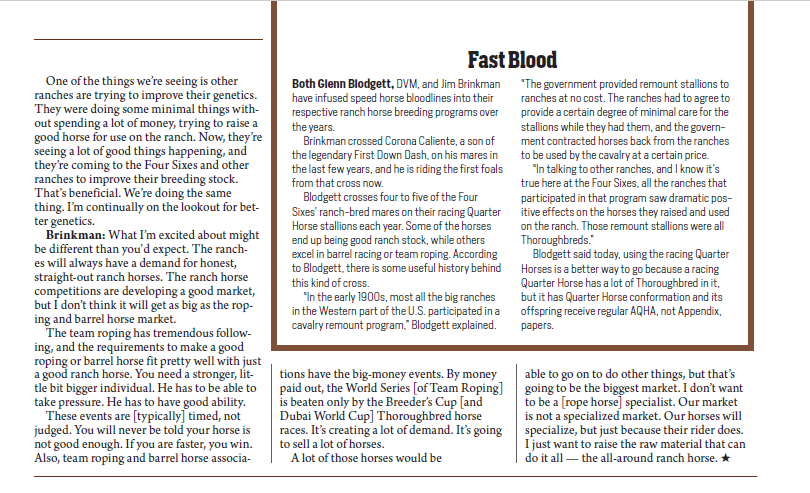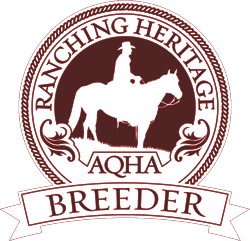Quarter Horse News
May 15, 2020
Article by Erin Haynes
Photos by Ross Hecox
Breeding experts Dr. Glenn Blodgett and Jim Brinkman discuss the progression of ranch horses and how stock horse competitions are making an impact.
Most of those who talk about the influence of great horses like Doc O’Lena and Gay Bar King never got to lay hands or even eyes on the legends. As a young horse show junkie on the road with his grandfather Howard Pitzer, Jim Brinkman was one of the fortunate few.
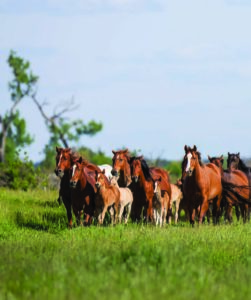
That firsthand experience observing such legendary horses still inspires Brinkman as he guides the Pitzer Ranch’s breeding program — one that began with another legend: Pitzer’s stallion Two Eyed Jack, who sired 14 American Quarter Horse Association (AQHA) Open World Champions and 119 Open AQHA Champions. The legacy continues today with a 400-head broodmare band and 12 standing stallions at the Ericson, Nebraska, ranch, which produces performance and ranch horses and holds two annual sales, each averaging 400 head (including consignments).
When Dr. Glenn Blodgett joined the Four Sixes Ranch as head veterinarian and horse division manager, the bloodlines of storied horses like Joe Hancock and Hollywood Gold were the foundation of the horse breeding program. During his nearly 40 years in Guthrie, Texas, Blodgett’s work with that stock has resulted in the program becoming an all-time leading breeder of AQHA performance horses and winner of the AQHA Best Remuda Award in 1993.
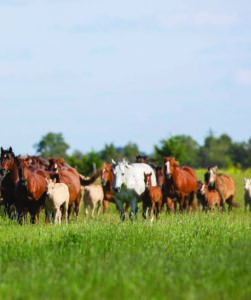
Today, the Four Sixes maintains a 70-horse broodmare band and stands multiple performance and racehorse stallions, producing dozens of foals each year for sale and for the ranch’s cowboys.
Brinkman and Blodgett, two horsemen who are at the forefront of the ranch horse industry’s development but are rooted in legendary heritage, each sat down to share their insights on how ranch horse breeding has evolved into an industry that flourishes today.
Quarter Horse News (QHN): How has ranch horse breeding evolved?
Dr. Glenn Blodgett: The type of ranch work we’re doing [at the Four Sixes] and the type of horse we’re raising is the same as it was 30 years ago, except we’re making one that can do the job better, stay sounder longer and also be in demand for the public. Our major goal is to produce a useful horse on the ranch and, at the same time, market to the public. We try to incorporate popular bloodlines that would be desirable to the public.
I would hope that the conformation is better today. The goal is always a better-conformed horse. These working ranch horses today are much more user-friendly. Their temperaments are better; some of that is training. Particularly when we incorporate some of the popular, proven cutting bloodlines into the ranch horse, those horses have more expression than horses used to have. And anybody who has been breeding strictly for speed knows horses are faster than they were, and our ranch horses have gotten faster, too.
Jim Brinkman: The old ranch horses, they were good 8-year-olds; they weren’t good 3-year-olds. It took longer to get them broke. They were a colder-blooded, stronger horse — a horse you’d make the outside circle on. Nowadays, lots of places make the outside circle on a four-wheeler, and they haul their horses to the pens in a trailer.
I wouldn’t say the horses aren’t as sound, but they’re not as rugged. You turned out the old horses into the hills for the winter, they lived on willow trees and tall grass, and they grew [long] hair on their legs. They were very tough. They had to be or they didn’t make it.
Nowadays, most horses are kept in a barn. Consequently, they’re a little softer and easier to get along with. A horse cow-kicking you when you cinch him up, we don’t have very much of that anymore.
In general, horses don’t have as good withers as they used to. Withers are an important thing we should retain. The cutters and reiners like a horse that kind of runs downhill. It helps their events, but it’s a bad deal for a ranch horse because he’s got to have a wither if he’s going to have a saddle on him all day and not be sore.
Horses today definitely have more “cow.” There were some pretty cowy horses in the old days, too, but we have bred these horses like Border Collies over the last 20 to 30 years. They also stop bigger.
QHN: Can you describe the current ranch horse market?
Blodgett: I can tell you consistently, through good times or bad times, there is always a strong market for the middle-aged, gentle, all-around usable gelding. We get calls for those all the time. It doesn’t matter if the economy is in the tank, the beef prices are in the tank, the oil prices are in the tank— those horses are in big demand and people are willing to pay good money for them all the time.
But that’s not the only type of horse we’re selling. We want to sell some of these younger horses that aren’t even started that probably have more value if they can be a show horse, and then a breeding animal. That’s why we try to be mindful of popularity of bloodlines and [breed for] horses that could do that kind of thing but, at the same time, do all the things we need them to do on the ranch. We’re trying to satisfy the public and ourselves.
“We’re not breeding here specifically for a ranch versatility show horse, but I think most of our horses just naturally fit that.”— Dr. Glenn Blodgett
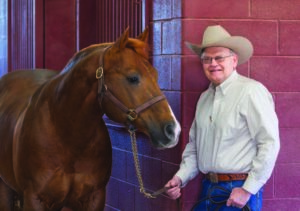
We’d really like to be able to produce one that would do all the things we want it to do, and then if somebody in Houston, Texas, wanted to buy it and ride it on the weekends, it would do all the things they wanted to do. There would be a lot of things in between us and that person, a lot of other of things that horse could do, because the ranch horse is truly the most versatile all-around horse.
Brinkman: There is demand all over the place for horses. If you have one that’s any good, somebody wants it. The secret is most people have neither the time nor the knowledge to make them. So, if you will make one and he is still in a competitive price arena, the same range as a four-wheeler, there is all kind of demand.
It’s hard to fill the demand. When you get up where he’s the same cost as a pickup, there are less people who want to buy him. But if you can keep him around $15,000, then he’s sold. There are a lot more [people] riding mares the last couple years because there are not enough [geldings].
Our biggest market is what we based our Pitzer Ranch Horse Invitational [competition] on. People want a horse they can go gather and sort the cows on, rope a sick one, and then go into the jackpot on the weekend and maybe let their daughter run him in the barrels while they’re there. If you’ve got one that fits multiple spots, he’s a very expensive horse. People are lining up for him.
“I just want to raise the raw material that can do it all — the all-around ranch horse.”— Jim Brinkman
QHN: Has the development and growth of ranch versatility events impacted breeding?
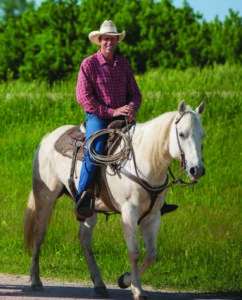
Blodgett: That segment of the AQHA and the show industry has just exploded. We’re seeing that interest filter down into the ranches in the breeding, but the true biggest explosion has been at the show level. Those people are going to be seeking more horses, and they are going to have to come to the ranches to get those kinds of horses.
We’re not breeding here specifically for a ranch versatility show horse, but I think most of our horses just naturally fit that. People have been taking horses from some of those other disciplines, basically because those horses were being ridden. If people start from scratch and buy a weanling or yearling, that horse is going to be 3 or 4 years old before they can show.
Brinkman: Just a little bit. Most of the horses showing in [those events] are horses they are pulling out of the other disciplines in the Quarter Horse shows. They haven’t started to specialize in that kind of horse yet, but that’s really a new part of the industry. It takes longer to filter down than you think it does.
QHN: What most excites you about the future of ranch horse breeding?
Blodgett: I think it’s going to get better because of the way the ranch horse shows have grown. Our horse has always been in demand by people wanting a pleasurable horse to ride, and now we have other people besides other ranches that want to do something with a horse and be at one of these shows.
One of the things we’re seeing is other ranches are trying to improve their genetics. They were doing some minimal things without spending a lot of money, trying to raise a good horse for use on the ranch. Now, they’re seeing a lot of good things happening, and they’re coming to the Four Sixes and other ranches to improve their breeding stock. That’s beneficial. We’re doing the same thing. I’m continually on the lookout for better genetics.
Brinkman: What I’m excited about might be different than you’d expect. The ranches will always have a demand for honest, straight-out ranch horses. The ranch horse competitions are developing a good market, but I don’t think it will get as big as the roping and barrel horse market.
The team roping has tremendous following, and the requirements to make a good roping or barrel horse fit pretty well with just a good ranch horse. You need a stronger, little bit bigger individual. He has to be able to take pressure. He has to have good ability.
These events are [typically] timed, not judged. You will never be told your horse is not good enough. If you are faster, you win. Also, team roping and barrel horse associations have the big-money events. By money paid out, the World Series [of Team Roping] is beaten only by the Breeder’s Cup [and Dubai World Cup] Thoroughbred horse races. It’s creating a lot of demand. It’s going to sell a lot of horses.
A lot of those horses would be able to go on to do other things, but that’s going to be the biggest market. I don’t want to be a [rope horse] specialist. Our market is not a specialized market. Our horses will specialize, but just because their rider does. I just want to raise the raw material that can do it all — the all-around ranch horse. ★
Fast Blood
Glenn Blodgett, DVM, and Jim Brinkman have infused speed horse bloodlines into their respective ranch horse breeding programs over the years.
Brinkman crossed Corona Caliente, a son of the legendary First Down Dash, on his mares in the last few years, and he is riding the first foals from that cross now.
Blodgett crosses four to five of the Four Sixes’ ranch-bred mares on their racing Quarter Horse stallions each year. Some of the horses end up being good ranch stock, while others excel in barrel racing or team roping. According to Blodgett, there is some useful history behind this kind of cross.
“In the early 1900s, most all the big ranches in the Western part of the U.S. participated in a cavalry remount program,” Blodgett explained.
“The government provided remount stallions to ranches at no cost. The ranches had to agree to provide a certain degree of minimal care for the stallions while they had them, and the government contracted horses back from the ranches to be used by the cavalry at a certain price.
“In talking to other ranches, and I know it’s true here at the Four Sixes, all the ranches that participated in that program saw dramatic positive effects on the horses they raised and used on the ranch. Those remount stallions were all Thoroughbreds.”
Blodgett said today, using the racing Quarter Horses is a better way to go because a racing Quarter Horse has a lot of Thoroughbred in it, but it has Quarter Horse conformation and its offspring receive regular AQHA, not Appendix, papers.
